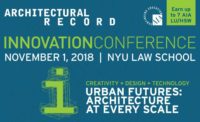Innovation at Every Scale
Using high technology and low, architects are pushing new ideas in design and construction.
Every year at this time, a new crop of students is busy assembling applications and portfolios for architecture school. In this issue of record, we're publishing our annual rankings of the best graduate and undergraduate programs in the United States, from research conducted and analyzed by the DesignIntelligence group. Despite the costs of higher education-and the hammering the profession has taken in this economy-becoming an architect is still a powerful aspiration. In 2011, enrollment in architecture schools was down only 1.1 percent from the previous academic year, and the student survey included in our report (page 67) indicates that 82 percent of the respondents plan to become registered architects.

Anyone who can't understand why architecture remains such an alluring profession should have dropped in on record's 10th annual Innovation conference in New York last month, titled “Design Leaders Envision the Next Decade”. The stellar lineup of speakers exemplified the best in innovative thinking and practice, not only in the use of rapidly changing digital technology but in research, sustainability, and explorations in materials, engineering, and construction. The day belonged to newer leaders as well as more senior professionals: One of the panels celebrated the successes of four architects under 50 who had previously been chosen as significant emerging talents in record's Design Vanguard program. Two of the keynote speakers-Jeanne Gang and David Adjaye-were also former Vanguard winners.
Throughout the conference, the audience saw striking displays of innovation at every scale, from a small vaulted laminated-wood pavilion at Lincoln Park Zoo in Chicago by Studio Gang Architects to details for the tapering Kingdom Tower in Saudi Arabia by Adrian Smith + Gordon Gill Architecture, which will be the world's tallest skyscraper when it opens in 2017. Also shifting scales was William Pedersen, founding partner of Kohn Pedersen Fox, who joked that he'd spent more time perfecting the design of his “loop” chair than he has on some of his supertall structures-but the ideas behind both were connected. “A chair can inform a building, and a building, a chair,” he said.
Material experimentation provided a common thread, too. Sheila Kennedy and her team at Kennedy & Violich like to subvert traditional materials, such as the marble they sliced to form thin plates for the entrance to Golkin Hall at the University of Pennsylvania Law School or the cloth “walls” that harness solar energy in a housing project in Germany. Even commonplace applications of materials can lead to innovative solutions, as the Berlin-based architect Francis Kéré explained in his inspiring presentation about the schools and library he's designed of brick, stone, wood, and corrugated iron in his native village in Burkina Faso, constructed with the labor of the local community.
We heard, of course, about digital technology. “Computing performance doubles every 18 months,” said Dennis Shelden, chief technology officer at Gehry Technologies, and that enables increasingly ambitious architecture and improved integration of design and construction. Yet even with technological advances occurring at warp speed, the source of innovation is human and often messy, as many architects get their hands dirty, testing materials, making prototypes, and soaking up ideas from everywhere, including old-fashioned books. (“There are many volumes in our office library,” said Jennifer Luce, “and very few are about architecture.”) In this age of media complexity, as Gang put it, “most of the attention is on digital tools. But at our office we find that the newest technologies work best when supplemented by other forms of thinking and making, including hand-drawing, model-making, material experiments, and other forms of low-tech creativity.”
Sometime in the future, people may look back at this moment-when we enthusiastically engage both high tech and low-and see it as just a blip in history. But now it seems an exciting time for the next generation of architects to explore a vast landscape of creative possibility.



